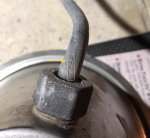A few weeks ago I went to turn on the pool like and the gfci tripped. Today I finally got around to pulling the light and saw water in it. After I dried it out with a heat gun and left it in the sun all afternoon, tested it and it tripped again. Tested the junction and there was something up with the wiring to the fixture, but it was dry on the inside. Hit it again with the heat gun, inside and outside, just because lol, and then it started to pass the tests. Tested the junction, then wired everything back up and put in a bulb and everything was good. So I got a new gasket and put it back in the pool. Once in water it worked for a second then tripped again. I pulled the light out and there was a little water in there. Since I tightened it so tight that I physically couldnt turn the nut anymore, I thought the light was just toast. I came here to look at light fixture options and saw this:
 www.troublefreepool.com
www.troublefreepool.com
So I looked at power cord and saw what looks like a small crack in the cable.

Previously the light was out of water for around 2 months (july to almost september) while the pool got resurfaced, and the light fixture (R400BCL) is probably at least 20 years old, so it must have cracked during that time. Anyways, the thread above mentions using epoxy, but I was wondering if I could use a few coatings of liquid electrical tape. I can buy that tomorrow, but a marine grade sealant that will work under the waterline will probably have to be ordered. Also, where the strain relief should be there is threading and a fastener...should I just cover that whole thing including the crack with whatever sealant I use?
Amerilite Pool Light Leaks. A Fix and what I've learned
One of the first things i noticed on my first pool at teh house I just moved into was that the shallow end pool light was not functioning I did a bit of research and ordered the new gasket and lamp. Installed it and everything went well for about 3 minutes when "Blooouup" a big ol bubble...
So I looked at power cord and saw what looks like a small crack in the cable.

Previously the light was out of water for around 2 months (july to almost september) while the pool got resurfaced, and the light fixture (R400BCL) is probably at least 20 years old, so it must have cracked during that time. Anyways, the thread above mentions using epoxy, but I was wondering if I could use a few coatings of liquid electrical tape. I can buy that tomorrow, but a marine grade sealant that will work under the waterline will probably have to be ordered. Also, where the strain relief should be there is threading and a fastener...should I just cover that whole thing including the crack with whatever sealant I use?

